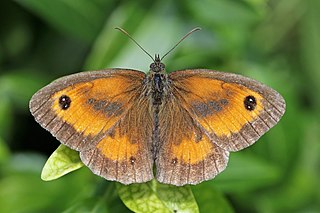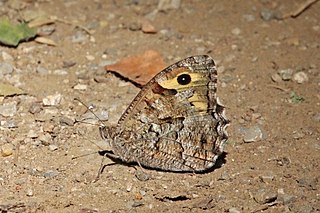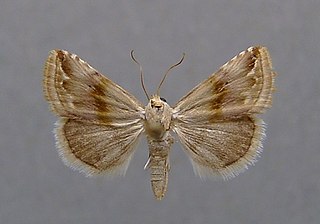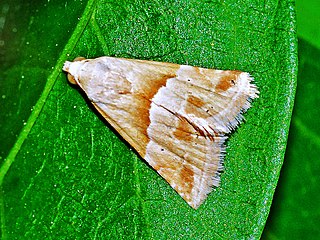
The Nymphalidae are the largest family of butterflies, with more than 6,000 species distributed throughout most of the world. Belonging to the superfamily Papilionoidea, they are usually medium-sized to large butterflies. Most species have a reduced pair of forelegs and many hold their colourful wings flat when resting. They are also called brush-footed butterflies or four-footed butterflies, because they are known to stand on only four legs while the other two are curled up; in some species, these forelegs have a brush-like set of hairs, which gives this family its other common name. Many species are brightly coloured and include popular species such as the emperors, monarch butterfly, admirals, tortoiseshells, and fritillaries. However, the under wings are, in contrast, often dull and in some species look remarkably like dead leaves, or are much paler, producing a cryptic effect that helps the butterflies blend into their surroundings.

The small heath is a butterfly species belonging to the family Nymphalidae, classified within the subfamily Satyrinae. It is the smallest butterfly in this subfamily. The small heath is diurnal and flies with a noticeable fluttering flight pattern near the ground. It rests with closed wings when not in flight. It is widespread in colonies throughout the grasslands of Eurasia and north-western Africa, preferring drier habitats than other Coenonympha, such as salt marshes, alpine meadows, wetlands, and grasslands near water. However, habitat loss caused by human activities has led to a decline in populations in some locations.

The meadow brown is a butterfly found in the Palearctic realm. Its range includes Europe south of 62°N, Russia eastwards to the Urals, Asia Minor, Iraq, Iran, North Africa and the Canary Islands. The larvae feed on grasses.
A gatekeeper is a person who controls access to something.

The gatekeeper or hedge brown is most commonly found in southern and eastern Britain and coastal areas of south and south-east Ireland. It is also found in the Channel Islands, but not in Scotland nor the Isle of Man. Given its preference for warmer weather, the restriction of range expansion can be assumed to be due to climate. Colonies vary in size depending on the available habitat, and can range from a few dozen to several thousand butterflies.

The dark green fritillary is a species of butterfly in the family Nymphalidae. The insect has a wide range in the Palearctic realm - Europe, Morocco, Iran, Siberia, Central Asia, China, Korea, and Japan.

The large tortoiseshell or blackleg tortoiseshell is a butterfly of the family Nymphalidae.

Hipparchia is a genus of butterflies within the family Nymphalidae. The genus was erected by Johan Christian Fabricius in 1807.

Lasiommata maera, the large wall brown, is a butterfly in the family Nymphalidae.

Spialia sertorius, the red-underwing skipper, is a butterfly of the family Hesperiidae. It is found in southern and central Europe and North Africa. This is a species of mountainous regions, being found in Europe at altitudes of up to 1400 m.

Pyronia bathseba, the Spanish gatekeeper, is a butterfly of the family Nymphalidae. It is found on the Iberian Peninsula and in France, Morocco, and Algeria. A similar gatekeeper species is Pyronia tithonus, which is found in northern Europe.
Trombidium breei is a species of red mite in the genus Trombidium in the family Trombidiidae. It is found in Europe. The larvae are parasites/hosts of certain butterflies (Lepidoptera), particularly meadow brown, gatekeeper, marbled white, common blue and small skipper. They attach themselves to the thorax or legs of the butterfly and transfer from host to host when the butterflies alight to nectar at flowers.

Chazara briseis, the hermit, is a butterfly species belonging to the family Nymphalidae. It can be found in North Africa, southern Europe, Asia Minor, the Caucasus, Kazakhstan, Central Asia through Afghanistan, and north-western China and Tuva. It is found on steppe and in other dry grassy places between 500 and 2,500 meters.

Polyommatus thersites, the Chapman's blue, is a butterfly in the family Lycaenidae. It is found in southern Europe, Morocco, Lebanon, Asia Minor, Iran and across the Palearctic to Siberia and Tian Shan.

Pyronia cecilia, the southern gatekeeper, is a butterfly of Southern Europe and North Africa. It is a member of the subfamily Satyrinae in the family Nymphalidae.

Eublemma ostrina, the purple marbled, is a moth of the family Erebidae. The species was first described by Jacob Hübner in 1808. It is mainly found in central and southern Europe, and further east, but is also a scarce migrant in the United Kingdom, where it is mainly found along the south coast.

Eublemma parva, the small marbled, is a moth of the family Erebidae. The species was first described by Jacob Hübner in 1808.

Pseudophilotes bavius, the Bavius blue, is a butterfly of the family Lycaenidae. It is found in Morocco, Algeria, Bulgaria, Romania, Greece, Asia Minor, southern Russia and northern Kazakhstan. The species occurs in small isolated populations on flower-rich, dry grassland, on dry, stony slopes and on open patches in shrub and in vineyards on calcareous soil.
















